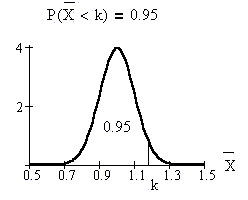|

Lesson 7.2 The Central Limit Theorem for Means
or Averages
Notation and
Formulas
X is a random variable with a distribution that
may be known or unknown. Using a subscript that
matches the random variable, suppose
- μX = the mean of X.
- σX = the standard deviation of X.
If you draw random samples of size n, then as n
increases, the random variable

of the sample averages tends to be normally
distributed as follows:

Notice that the mean of the sample averages is
the same as the mean of the original distribution,
but the standard deviation of the sample averages
is the standard deviation of the original
distribution divided by the square root of n.

Law of Large Numbers
The Law of Large Numbers says that if you take
larger and larger samples from any population,
then the sample mean gets closer to the population
mean. The Central Limit Theorem (CLT) says that as
the sample size n gets larger, the sample means
follow a normal distribution. As n gets larger,
the standard deviation for the averages gets
smaller. As the standard deviation for the
averages gets smaller, the sample means get closer
to the population mean.

CLT Problems for
Averages Using TI-83 or TI-84 calculators
Example: The length of time, in hours, it takes
an "over 40" group of athletes to play an indoor
soccer match has an unknown distribution. The mean
is 1 hour and the standard deviation is 0.5 hours.
Suppose, 25 of these soccer matches are randomly
chosen.
Let X = the length of time, in hours, it takes to
play one of these soccer matches. Then,

and follows a normal distribution:

where μX = 1 and σX = 0.5.

Below are some typical problems. The answers have
been calculated using technology (TI-83
calculator).
|
What is the probability that the
average length of time of 25 soccer
matches is less than 1.1 hours?

The probability that the average length
of 25 soccer matches is less than 1.1
hours is 0.8413.
This calculation was done using TI-83
or TI-84 calculator function 2nd DISTR.

What is the probability that the
average length of time of 25 soccer
matches is between 1 and 1.1 hours?

The probability that the average length
of time of 25 soccer matches is between
1 and 1.1 hours is 0.3413.
This calculation was done using TI-83
or TI-84 calculator function 2nd DISTR.

Find the 95th percentile for the
average length of time of 25 soccer
matches.
Let k = the 95th percentile (95%ile).

k = 1.17 (to 2 decimal places).
The 95th percentile is 1.17 hours. This
means that 95% of the average lengths of
soccer matches are less than 1.17 hours.
This calculation was done using TI-83
or TI-84 calculator function 2nd DISTR.

The IQR (interquartile range) for the
average length of a soccer match is from
____ to ____. IQR = ____
The IQR is the spread of the middle 50%
of all average lengths of soccer
matches. IQR = Q3 - Q1.
Q3 = the 75th percentile and Q1 = the
25th percentile

Q3 = 1.07 and Q1 = 0.93 (to 2 decimal
places).
These calculations were done using
TI-83 or TI-84 calculator function 2nd
DISTR.


The IQR goes from 0.93 to 1.07 hours.
IQR = 1.07 - 0.93 = 0.14 hours.
|
Examples
1) The
following problem is concerned with the
average percent of calories from fat that a person
from the United States consumes. Close the window
when you are finished viewing the example. You
will return here.
2) The next
example is concerned with the average stress
score of students. The stress scores follow a
uniform distribution but, by the CLT, the average
stress scores follow a normal distribution. Close
the window when you are finished viewing the
example. You will return here.
Think About It
The length of time to brush one's teeth is
generally thought to be exponentially distributed
with a mean of 0.75 minutes.
- Find the probability that the average time it
takes 50 people to brush their teeth is more
than 0.8 minutes.
- Find the 95th percentile for the average time
it takes 50 people to brush their teeth.
For the probability problem, use your calculator
and the normal CDF function (normal CDF on the
TI-83). The mean of the averages is equal to the
original mean. The standard deviation of the
averages is the original standard deviation (it is
0.75, the same as the mean) divided by the square
root of the sample size.
The range of average times goes from 0.8 to
1EE99. Answer is 0.3187. For the percentile
problem, use the inverse norm function (invNorm on
the TI-83). The area to the left is .95. Answer is
0.92.
This is the last required section of this lesson.
Please continue to the optional section of this
lesson. When you have completed the assignment and
the quiz for Lesson 7, you are ready to begin
Lesson 8 - Confidence Intervals.
Please continue to the next section
of this lesson.
Up » 7.1
Central Limit Theorem »
7.2 Central Limit Theorem for Averages »
7.3 Central Limit Theorem for Sums
|